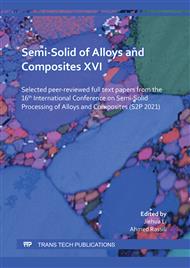p.3
p.11
p.26
p.33
p.45
p.54
p.65
p.71
p.82
Effect of the Mg3N2 Sub-Micron Particle on the Grain Refinement of AZ80 Alloy
Abstract:
AZ80 alloy has been widely used to produce high performance Mg casting and wrought parts for high-end applications due to its high mechanical properties and deformation ability. However, at least two important issues still need to be solved in order to further improve its mechanical properties and deformation ability. Firstly, the grain size of α-Mg in AZ80 alloy is relatively large (more than 1000 µm) due to a lack of efficient grain refinement methodologies. Secondly, the size of the eutectic Mg17Al12 phase is also large and the distribution of the eutectic Mg17Al12 phase is continuous, which is very harmful for the mechanical properties, in particular to elongation. In this paper, these two important issues are investigated by adding Mg3N2 sub-micron particle into AZ80 alloy and thereby refining the α-Mg and the eutectic Mg17Al12 phase. Firstly, the Mg3N2 sub-micron particle was directly added into AZ80 alloy by using mechanically stirring in the semi-solid state, subsequently the melting temperature was increased above the liquidous temperature, and finally the melting was casted in the liquid state. It was found that the grain size of α-Mg can be refined from 883.8 µm to 169.9 µm. More importantly, the eutectic Mg17Al12 phase was also refined and the distribution became discontinuous. It should be noted that directly adding the Mg3N2 sub-micron particle into AZ80 alloy leads to a great loss of the Mg3N2 sub-micron particle due to the weak wetting behavior between the Mg3N2 sub-micron particle and Mg melt. The second methodology through mixing Mg3N2 sub-micron particles with AZ91 chips using a twin extruder was also used to prepare AZ91 master alloy with 3wt.% Mg3N2 sub-micron particle, which was subsequently added into AZ80 alloy in the liquid state. In this way, a significant grain refinement of α-Mg and a simultaneous refinement of the eutectic Mg17Al12 phase in AZ80 alloy was also achieved. The grain size of α-Mg can be refined from 883.8 µm to 325.9 µm. However, no significant grain refinement by using UST was observed. Instead, the grain size increases from 325.9 µm to 448.6 µm, indicating that the Mg3N2 sub-micron particle may lose its grain refinement potency due to possible aggregation and clustering. This paper provides an efficient and simple methodology for the grain refinement of α-Mg and the simultaneous refinement of the eutectic Mg17Al12 phase in AZ80 alloy.
Info:
Periodical:
Pages:
45-53
Citation:
Online since:
January 2022
Authors:
Price:
Сopyright:
© 2022 Trans Tech Publications Ltd. All Rights Reserved
Share:
Citation:


